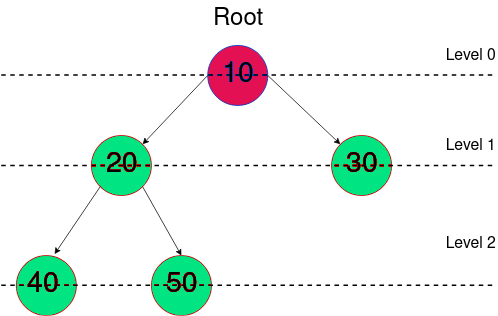在二叉树中进行层次遍历
层次遍历是一种横向遍历二叉树的方法之一。在本文中,我们将讨论如何在C/C++中实现这个算法。
但在此之前,让我们先梳理一下我们的概念。
构建概念
二叉树是一种数据结构,每个节点最多有两个子节点。最上方的节点被称为根节点。

遍历二叉树的常见方式有四种,分别是:
- In order Traversal
- Pre Order Traversal
- Post Order Traversal
- Level Order Traversal
让我们来了解二叉树中的层级意味着什么。
一个级别是树中与给定节点对应的父节点的数量。基本上就是从该节点到根节点的祖先数量。
所以,对于根节点(最顶层节点)而言,它的层级是0,因为它没有父节点。如果它有子节点,那么它们的层级都会是1,因为在根节点之前它们只有一个祖先,即根节点本身。

我们还需要理解二叉树中的高度概念。这其实就是从根节点到树中最深节点的路径长度。
在这种情况下,高度将是从最深叶节点(40或50,因为它们具有最大层级)到根的长度。因此,树的高度为2。
现在我们已经掌握了概念,让我们来了解如何实施层序遍历。
层次遍历
层次遍历是一种总是根据树的层级进行遍历的方法。
所以,这个遍历首先遍历与Level 0相对应的节点,然后是Level 1,依此类推,从根节点开始。
在上面的二叉树例子中,层序遍历的顺序将会是:
(起始值)10 – > 20 -> 30 -> 40 -> 50
为了做到这一点,我们需要做两件事情。
- 我们首先必须找出这棵树的高度。
我们需要找到一种方法来打印每个层级对应的节点。
找到树的高度
首先我们会找到树的高度。要做到这一点,逻辑很简单。
由于树的高度被定义为从根节点到叶子节点的最长路径,因此我们可以递归地计算左右子树的高度,并找到子树中的最大高度。树的高度将简单地等于子树的高度加1。
C-风格的伪代码:
// Find height of a tree, defined by the root node
int tree_height(Node* root) {
if (root == NULL)
return 0;
else {
// Find the height of left, right subtrees
left_height = tree_height(root->left);
right_height = tree_height(root->right);
// Find max(subtree_height) + 1 to get the height of the tree
return max(left_height, right_height) + 1;
}
打印每一级的所有节点。
现在我们已经有了树的高度,我们需要为每个层级打印节点。为了做到这一点,我们将使用一个for循环来迭代所有层级直到树的高度,并打印每个层级的节点。
void print_tree_level_order(Node* root) {
int height = tree_height(root);
for (int i=0; i<height; i++) {
// Print the ith level
print_level(root, i);
}
}
观察到我们需要另一个函数来打印树的第i层。
再次,我们有一个类似的逻辑。但这次,在打印根节点后,我们将根节点更改为其左子节点和右子节点,并打印两个子树。
直到我们到达叶子节点,也就是辅助根节点在下一步将为NULL的时候,这将会继续进行。(因为叶子节点的左指向NULL且右指向NULL)
void print_level(Node* root, int level_no) {
// Prints the nodes in the tree
// having a level = level_no
// We have a auxiliary root node
// for printing the root of every
// sub-tree
if (!root)
return;
if (level_no == 0) {
// We are at the top of a sub-tree
// So print the auxiliary root node
printf("%d -> ", root->value);
}
else {
// Make the auxiliary root node to
// be the left and right nodes for
// the sub-trees and decrease level by 1, since
// you are moving from top to bottom
print_level(root->left, level_no - 1);
print_level(root->right, level_no - 1);
}
}
现在,我们终于完成了层序遍历!
我将在下面提供完整的程序,其中还包含使用插入方法构建二叉树的部分。
完整的 C/C++ 代码
尽管这原本是一段C程序,但同样可以在C++上编译。
/**
Code for https://journaldev.com
File Name: level_order.c
Purpose: Find the Level Order Traversal of a Binary Tree
@author Vijay Ramachandran
@date 28/01/2020
*/
#include <stdio.h>
#include <stdlib.h>
typedef struct Node Node;
// Define the Tree Node here
struct Node {
int value;
// Pointers to the left and right children
Node* left, *right;
};
Node* init_tree(int data) {
// Creates the tree and returns the
// root node
Node* root = (Node*) malloc (sizeof(Node));
root->left = root->right = NULL;
root->value = data;
return root;
}
Node* create_node(int data) {
// Creates a new node
Node* node = (Node*) malloc (sizeof(Node));
node->value = data;
node->left = node->right = NULL;
return node;
}
void free_tree(Node* root) {
// Deallocates memory corresponding
// to every node in the tree.
Node* temp = root;
if (!temp)
return;
free_tree(temp->left);
free_tree(temp->right);
if (!temp->left && !temp->right) {
free(temp);
return;
}
}
int tree_height(Node* root) {
// Get the height of the tree
if (!root)
return 0;
else {
// Find the height of both subtrees
// and use the larger one
int left_height = tree_height(root->left);
int right_height = tree_height(root->right);
if (left_height >= right_height)
return left_height + 1;
else
return right_height + 1;
}
}
void print_level(Node* root, int level_no) {
// Prints the nodes in the tree
// having a level = level_no
// We have a auxiliary root node
// for printing the root of every
// subtree
if (!root)
return;
if (level_no == 0) {
// We are at the top of a subtree
// So print the auxiliary root node
printf("%d -> ", root->value);
}
else {
// Make the auxiliary root node to
// be the left and right nodes for
// the subtrees and decrease level by 1, since
// you are moving from top to bottom
print_level(root->left, level_no - 1);
print_level(root->right, level_no - 1);
}
}
void print_tree_level_order(Node* root) {
if (!root)
return;
int height = tree_height(root);
for (int i=0; i<height; i++) {
printf("Level %d: ", i);
print_level(root, i);
printf("\n");
}
printf("\n\n-----Complete Level Order Traversal:-----\n");
for (int i=0; i<height; i++) {
print_level(root, i);
}
printf("\n");
}
int main() {
// Program to demonstrate Level Order Traversal
// Create the root node having a value of 10
Node* root = init_tree(10);
// Insert nodes onto the tree
root->left = create_node(20);
root->right = create_node(30);
root->left->left = create_node(40);
root->left->right = create_node(50);
// Level Order Traversal
print_tree_level_order(root);
// Free the tree!
free_tree(root);
return 0;
}
输出
Level 0: 10 ->
Level 1: 20 -> 30 ->
Level 2: 40 -> 50 ->
-----Complete Level Order Traversal:-----
10 -> 20 -> 30 -> 40 -> 50 ->
您还可以通过我为此目的创建的Github gist下载它。(还包含插入代码的部分)
结论
希望你对如何在C/C++中实现层序遍历有了更好的理解。如果你有任何问题,请在下面的评论区随时提问!

